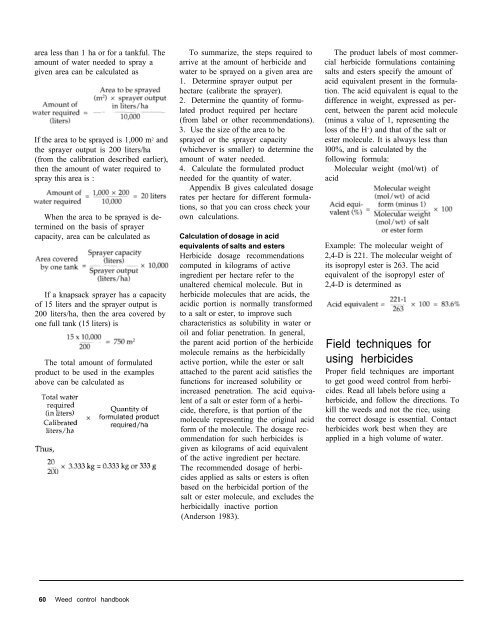A handbbok on Weed Control in Rice.pdf
A handbbok on Weed Control in Rice.pdf
A handbbok on Weed Control in Rice.pdf
Create successful ePaper yourself
Turn your PDF publications into a flip-book with our unique Google optimized e-Paper software.
area less than 1 ha or for a tankful. The<br />
amount of water needed to spray a<br />
given area can be calculated as<br />
If the area to be sprayed is 1,000 m 2 and<br />
the sprayer output is 200 liters/ha<br />
(from the calibrati<strong>on</strong> described earlier),<br />
then the amount of water required to<br />
spray this area is :<br />
When the area to be sprayed is de-<br />
term<strong>in</strong>ed <strong>on</strong> the basis of sprayer<br />
capacity, area can be calculated as<br />
If a knapsack sprayer has a capacity<br />
of 15 liters and the sprayer output is<br />
200 liters/ha, then the area covered by<br />
<strong>on</strong>e full tank (15 liters) is<br />
The total amount of formulated<br />
product to be used <strong>in</strong> the examples<br />
above can be calculated as<br />
60 <strong>Weed</strong> c<strong>on</strong>trol handbook<br />
To summarize, the steps required to<br />
arrive at the amount of herbicide and<br />
water to be sprayed <strong>on</strong> a given area are<br />
1. Determ<strong>in</strong>e sprayer output per<br />
hectare (calibrate the sprayer).<br />
2. Determ<strong>in</strong>e the quantity of formu-<br />
lated product required per hectare<br />
(from label or other recommendati<strong>on</strong>s).<br />
3. Use the size of the area to be<br />
sprayed or the sprayer capacity<br />
(whichever is smaller) to determ<strong>in</strong>e the<br />
amount of water needed.<br />
4. Calculate the formulated product<br />
needed for the quantity of water.<br />
Appendix B gives calculated dosage<br />
rates per hectare for different formula-<br />
ti<strong>on</strong>s, so that you can cross check your<br />
own calculati<strong>on</strong>s.<br />
Calculati<strong>on</strong> of dosage <strong>in</strong> acid<br />
equivalents of salts and esters<br />
Herbicide dosage recommendati<strong>on</strong>s<br />
computed <strong>in</strong> kilograms of active<br />
<strong>in</strong>gredient per hectare refer to the<br />
unaltered chemical molecule. But <strong>in</strong><br />
herbicide molecules that are acids, the<br />
acidic porti<strong>on</strong> is normally transformed<br />
to a salt or ester, to improve such<br />
characteristics as solubility <strong>in</strong> water or<br />
oil and foliar penetrati<strong>on</strong>. In general,<br />
the parent acid porti<strong>on</strong> of the herbicide<br />
molecule rema<strong>in</strong>s as the herbicidally<br />
active porti<strong>on</strong>, while the ester or salt<br />
attached to the parent acid satisfies the<br />
functi<strong>on</strong>s for <strong>in</strong>creased solubility or<br />
<strong>in</strong>creased penetrati<strong>on</strong>. The acid equiva-<br />
lent of a salt or ester form of a herbi-<br />
cide, therefore, is that porti<strong>on</strong> of the<br />
molecule represent<strong>in</strong>g the orig<strong>in</strong>al acid<br />
form of the molecule. The dosage rec-<br />
ommendati<strong>on</strong> for such herbicides is<br />
given as kilograms of acid equivalent<br />
of the active <strong>in</strong>gredient per hectare.<br />
The recommended dosage of herbi-<br />
cides applied as salts or esters is often<br />
based <strong>on</strong> the herbicidal porti<strong>on</strong> of the<br />
salt or ester molecule, and excludes the<br />
herbicidally <strong>in</strong>active porti<strong>on</strong><br />
(Anders<strong>on</strong> 1983).<br />
The product labels of most commercial<br />
herbicide formulati<strong>on</strong>s c<strong>on</strong>ta<strong>in</strong><strong>in</strong>g<br />
salts and esters specify the amount of<br />
acid equivalent present <strong>in</strong> the formulati<strong>on</strong>.<br />
The acid equivalent is equal to the<br />
difference <strong>in</strong> weight, expressed as percent,<br />
between the parent acid molecule<br />
(m<strong>in</strong>us a value of 1, represent<strong>in</strong>g the<br />
loss of the H + ) and that of the salt or<br />
ester molecule. It is always less than<br />
l00%, and is calculated by the<br />
follow<strong>in</strong>g formula:<br />
Molecular weight (mol/wt) of<br />
acid<br />
Example: The molecular weight of<br />
2,4-D is 221. The molecular weight of<br />
its isopropyl ester is 263. The acid<br />
equivalent of the isopropyl ester of<br />
2,4-D is determ<strong>in</strong>ed as<br />
Field techniques for<br />
us<strong>in</strong>g herbicides<br />
Proper field techniques are important<br />
to get good weed c<strong>on</strong>trol from herbi-<br />
cides. Read all labels before us<strong>in</strong>g a<br />
herbicide, and follow the directi<strong>on</strong>s. To<br />
kill the weeds and not the rice, us<strong>in</strong>g<br />
the correct dosage is essential. C<strong>on</strong>tact<br />
herbicides work best when they are<br />
applied <strong>in</strong> a high volume of water.











